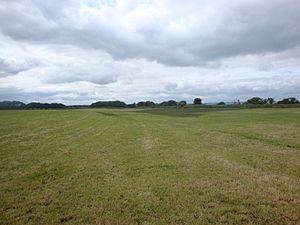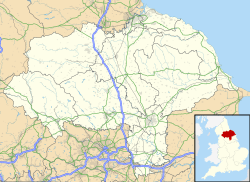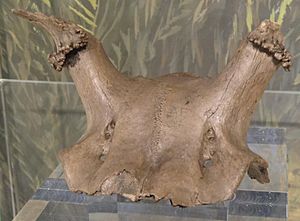Star Carr facts for kids

View of the Star Carr site looking north-west-west
|
|
| Location | Scarborough, North Yorkshire, England |
|---|---|
| Coordinates | 54°12′51″N 00°25′24″W / 54.21417°N 0.42333°W |
| Type | Settlement |
| History | |
| Founded | Approximately 9300 BC |
| Abandoned | Approximately 8480 BC |
| Periods | Mesolithic |
| The Mesolithic |
|---|
| ↑ Upper Paleolithic |
|
| ↓ Neolithic |
Star Carr is a very important ancient site in North Yorkshire, England. It's about five miles (8 km) south of Scarborough. This place is considered the most important Mesolithic site in Great Britain. It helps us understand the Mesolithic period, just like Stonehenge helps us understand the Neolithic period.
People lived at Star Carr during the early Mesolithic period. This was after the last Ice Age ended. Temperatures were similar to today, but Britain was still connected to continental Europe. Amazing finds include Britain’s oldest known building. Also found were 21 red deer skull-caps that might have been headdresses. Nearly 200 harpoon points made of red deer antler were also discovered. These items were saved because they were buried in wet peat. Usually, only stone tools are left from Mesolithic sites.
Archaeologists started digging at Star Carr in 1948. This was a year after an amateur archaeologist named John Moore first found some objects. The site is famous for its rare finds. New discoveries and ideas have shown how important Star Carr really is.
Contents
Life at Star Carr: What Was It Like?
The World Around Star Carr
Today, Star Carr is under farmland. But during the Mesolithic period, it was next to a large ancient lake called Lake Flixton. After the last Ice Age, the land changed. This caused the area to drain towards the west. The lake basin was likely formed by glaciers.
The site is well-preserved because Lake Flixton slowly filled with peat. Wet peat stops ancient objects from rotting away. This is why archaeologists found so many amazing things. These conditions are so good that they have even preserved famous bog bodies in other parts of Europe. Thanks to this, archaeologists found bone, antler, and wood. Normally, only flint tools are left from this time.
During the Mesolithic period, the area around the lake was a mixed forest. It had trees like birch, aspen, and willow. The lake edges were full of reeds and water lilies. The lake levels changed with rain and melting snow.
Many plants formed the base of a complex food web. We have found evidence of many mammals. These include plant-eaters like beaver, red deer, roe deer, elk, aurochs, and wild boar. There were also meat-eaters like wolf, lynx, bear, and fox.
Amazing Finds from Star Carr
Besides the usual flint tools, many objects were made from red deer and elk antler. Some were made from elk bone and aurochs bone. One piece of bird bone was also found. Rarer items included worked amber, shale, and haematite. A decorated pendant was also found. It is thought to be the oldest Mesolithic art in Britain. Small pieces of birch-bark and birch-resin tar were also discovered.
The flint used at Star Carr came from nearby beaches. These beaches would have been about 10 to 20 km away back then. Some flint also came from the Yorkshire Wolds to the south.
The two most special finds are the 'barbed points' and 'antler frontlets'. The barbed points are like harpoons. They are made from red deer antlers. They are between 8 cm and 38 cm long. The 195 examples found at Star Carr are more than 95% of all those found in the British Mesolithic. Many of these points and antler frontlets seem to have been broken on purpose.
The antler frontlets are made from red deer skulls with the antlers still attached. There are 21 of these. They were made by drilling two holes through the skull with a flint tool. The inside of the skull cap was smoothed. The antlers were carefully trimmed, perhaps to make them lighter. It seems very likely these were used as headgear, maybe for hunting or special ceremonies.
The finds from Star Carr are now in four museums. These are The British Museum, the Yorkshire Museum in York, the University Museum of Archaeology and Anthropology at Cambridge, and the Scarborough Museum.
Ancient Buildings at Star Carr
Archaeologists found signs of a building about 3.5 meters wide. These signs include post holes, a sunken area, and groups of flints and other objects. The posts were likely made of wood, about 20 cm wide. There might have been as many as 18 posts. The holes show that some posts were replaced over time.
We don't know what the walls or roof looked like. They might have used animal hides, thatch, turf, or tree bark. The building might have been shaped like a cone, like a teepee, or rounded, like a wigwam. It's possible they used different materials at different times. The floor was covered with a layer of moss, reeds, and other soft plants, about 20-30 cm deep.
Radiocarbon dating shows the building was used for 200 to 500 years. This structure is similar to another Mesolithic building found at Howick in Northumberland. It also reminds us of British Iron Age roundhouses.
A large wooden platform was also found nearby. It was on the shore of the ancient lake. This is the earliest known example of carpentry in Europe! We don't know its exact purpose yet. Pieces of aspen and willow wood were split using wedges. These wooden pieces were then laid in the wet areas by the lake. This was probably to create a firm surface to walk on. We don't know how big the wooden platform was. It might have been a much bigger project than the house-like structure.
When Was Star Carr Used?
Radiocarbon dating tells us that people first lived at Star Carr between 9335–9275 BC. They stayed for about 800 years, until 8525–8440 BC. However, people might have lived there on and off, with some periods being busier than others.
Exploring Star Carr: How We Learned About It
First Discoveries and Digs
Star Carr was found in 1947 by John Moore. He was an amateur archaeologist. He saw flint tools in ditches that had just been dug near the New Hertford River. Moore decided to dig a small trench at Star Carr in 1948. When he found well-preserved organic remains, he contacted Professor Grahame Clark from the University of Cambridge.
Clark started his own dig to learn more about the Mesolithic environment. He wanted to see how people used it. The amazing preservation allowed him to find plant and animal remains. Clark dug from 1949 to 1951. His book about these digs, published in 1954, is very important for studying British prehistory.
Clark thought he had uncovered the whole site. He believed Star Carr could be a key example for the British Mesolithic. He saw similarities between Star Carr and a site called Maglemose in Denmark. Today, we know some of Clark's ideas were not quite right. But his excavation is still one of the most important in British prehistory.
More Investigations: The Lake Flixton Area
In 1977, archaeologists dug up Iron Age, Bronze Age, and Mesolithic items at Seamer Carr. This was just north of Star Carr. These digs happened before a landfill site was built. Finding Mesolithic items led to new investigations around Lake Flixton. These were led by Tim Schadla-Hall. His team returned to Star Carr in 1985 and 1989.
This project looked at the wider area around Lake Flixton. They found several more Mesolithic sites. But none had as many unusual objects, like barbed points and antler frontlets, as Star Carr.
Recent Discoveries
New digs at Star Carr began in the 2000s. This project is led by Nicky Milner (University of York), Chantal Conneller (University of Manchester), and Barry Taylor (University of Chester). They have re-examined Clark's old digs and also dug in the dry land, where they found the ancient building.
Sadly, recent studies show that the preservation conditions have gotten worse. This means any remaining organic objects won't be as well-preserved as those found before. We don't know exactly why, but the groundwater has become much more acidic.
In 2015, a decorated pendant was found at the site. It's called the Star Carr Pendant. It's thought to be the oldest Mesolithic art in Britain. This 11,000-year-old object has been on display at the Yorkshire Museum since 2016.
What Do the Finds Mean?
Clark, the first archaeologist, thought Mesolithic people lived on a brushwood platform at the edge of the lake. But recent digs show that people lived on the dry land above the lake. They did different activities at the lake's edge.
There's a lot of discussion about when the site was used during the year. Mesolithic people hunted many animals, like red and roe deer, elk, aurochs, and wild boar. But different studies suggest different seasons. Since the site was used for hundreds of years, it's likely that seasonal activities changed over time.
Some people think the antler frontlets were used as a hunting disguise. Others believe they were part of a ritual or ceremony. Recent studies suggest that these, and other objects made from red deer antler, were carefully placed at the lake's edge. This might be because red deer were very important to the people who lived there.
Anthony Legge and Peter Rowley-Conway looked at the animal bones again. They found strong evidence that the site was only used in late spring and summer. They also found that they mostly hunted three-year-old red deer and one-year-old roe deer. They suggested the site was used as a hunting camp.
|





